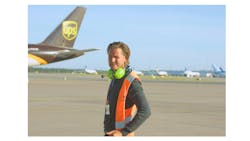Understanding Communications in Ground Operations
Pilots communicate with workers on the ramp using an internationally recognized industry-standard language of phrases, hand signals and radio communication. By contributing to situational awareness, everyone can help detect danger before incidents occur.
“Communication is an extremely large and important part of both the profession and the training for the profession as a ramp worker,” said David Stribe, corporate training coordinator at Aviator Airport Alliance. “…we need to ensure safety by monitoring from our side and we are in direct contact with the cockpit via headset.”
Aviator ramp employees start with basic training that covers hand signals, and other training modules teach aircraft marshalling.
The European Union Aviation Safety Agency’s report on 2023 aviation safety lists ground collisions as the fourth most common type of accident and serious incidents in Europe in 2019-2023.
First Communication
Communication between an aircraft and Aviator will usually begin upon arrival. The pilot at this point has completed an after-landing checklist and would have followed instructions from air traffic control to arrive at the gate. When the aircraft has come to a stop and engine shutdown has occurred, the pilots will disengage a flashing red beacon light, allowing the ground crew to begin work.
The ground crew will first place chocks at the wheels of the aircraft to ensure the aircraft is safe from movement. Ground crew can use hand signals, often bringing their fists together above their head, to communicate chocks are in place.
Ground crew will connect an interphone system via a headset to the aircraft to welcome the pilots to the airport and ensure that the ground power supply is connected, which allows the crew to continue their work on the aircraft. At this stage of arrival, communication becomes similar to taking orders at a busy restaurant. The crew will ask for individual aircraft needs then organize ground service equipment as needed.
Communication at the Gate
While parked at the gate and hooked up to the interphone system, communication becomes slightly more interpersonal as each aircrew has their own communication style that was adopted before they even arrived at the airport.
“Every part of communication between us and the pilots does not just follow a precise predetermined word order,” Stribe said. “Quite naturally, it may be that the cockpit chooses to communicate via local language.”
During the time on the ground, Aviator crew members work on many tasks to ready the aircraft for flight while standing by for any communication. Communication will begin at the pilot's discretion and could range from casual conversation about the World Cup to conversation about the airport where individuals on the ramp can enhance pilot situational awareness.
Communication at Departure
When the aircraft has been prepared and ready for flight, Aviator personnel follow predetermined and planned dialogs in accordance with regulations. When communication is following a familiar tempo to share planned information and procedure, headsets and hand signals are used. Unlike other communications, the ground crew will begin the departure process.
“We inform the cockpit that the departure check has been completed, that we have connected the pushback tractor and are ready for departure,” Stribe said.
At this time, marshallers will watch for things that pilots can't see from the flight deck, immediately raising attention to their supervisors if any conflicts are detected.
The pilot will activate the beacon light before the aircraft is moved and the engines are started, making areas outside the aircraft unsafe for ground personnel.
When the pushback is complete, the ground crew will disconnect a safety pin in the nose landing gear, enabling its free movement.
“We always end the communication by disconnecting the headset, moving away from the aircraft, directly in front and in the cockpit's field of vision, where we display the disconnected safety pin and give the crew the ‘thumbs up,’” Stribe said. “We always wait until the ‘thumbs up’ is answered from the cockpit, and that is then the sign that the aircraft will taxi out to take off and our work and communication with the cockpit is thus finished."
